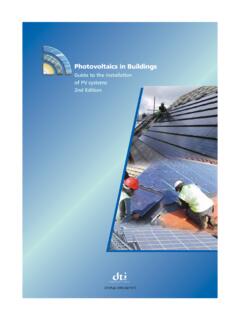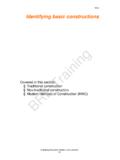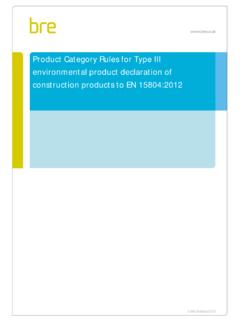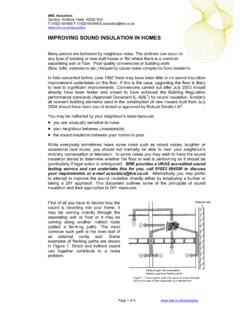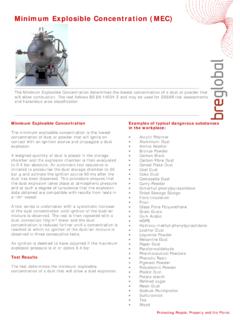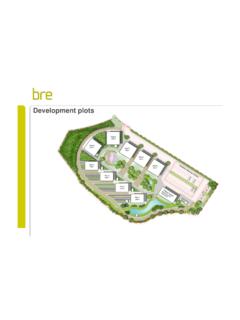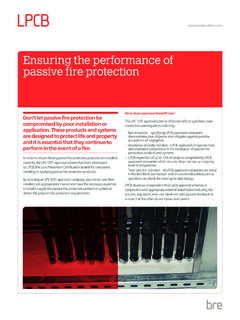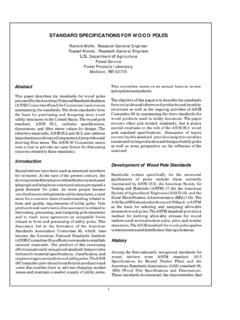Transcription of CROSS-LAMINATED TIMBER - BRE
1 INFORMATION PAPER IP 17/11 CROSS-LAMINATED TIMBERAn introduction to low-impact building materialsAndy Sutton and Daniel Black, BRE Pete Walker, University of BathThis Information Paper provides a broad view of the benefits and limitations of CROSS-LAMINATED TIMBER (CLT) for those considering its use in construction projects. CLT is an engineered TIMBER product with good structural properties and low environmental impact (where sustainably sourced TIMBER is used). It can provide dry, fast onsite construction, with good potential for airtightness and a robust wall and floor structure suitable for most finishes internally and externally. It requires only limited new site skills, and its low weight means that a high degree of offsite manufacture is possible. Access permitting, relatively large pre-manufactured panels can be transported to site for fast, factory-quality construction. Currently, CLT is manufactured abroad with an established supply into the UK market, although this brings higher environmental impact from typically increased transportation distances and some cost uncertainty with varying foreign exchange rates.
2 This is one in a series of five Information Papers and parallel case studies on low-impact building materials. The others cover hemp lime, straw bale, unfired clay masonry and natural fibre normally forms the structural floor and wall element of buildings, and has been used successfully to build up to nine storeys in the UK (Figure 2). It is typically used in offsite manufactured panels delivered to site for erection via crane. As an engineered TIMBER product, with the cross -grain movement controlled by the cross -lamination, it is broadly dimensionally stable and shrinks less than standard solid TIMBER construction. While it is usable on small projects, it is more often used on larger schemes where offsite manufacture and speed of construction can reduce is formed in a similar fashion to the more familiar glue- laminated TIMBER beams ( glulam ), using small sections of TIMBER bonded together with permanent adhesives (Figure 3).
3 In this way, imperfections in the original TIMBER , such as knots, can be removed in the factory to reduce variability and enhance structural performance. CLT differs from glulam in that it is formed into panels rather than beams, hence the layers of TIMBER (lamellas) are bonded perpendicularly to one another, resulting in structural strength across two dimensions, and improving structural integrity and dimensional stability. Various grades of finish are available, from covered to fair-faced (exposed). The completed panel is vapour permeable and so can be used as part of a breathing wall 1: CROSS-LAMINATED TIMBER can provide a finished surface as soon as it is installed installation of future fixtures and fittings is relatively quick and easy(Courtesy of Will Pryce) 103/11/2011 16:38:102 CROSS-LAMINATED TIMBER IP 17/11 The TIMBER used in CLT is kiln dried with a moisture content of around 12%, low enough to preclude pest or fungal attack.
4 It will typically be formed into a minimum of three layers, rising to usually no more than seven, depending on the structural requirements and desired thickness, with a practical maximum thickness of around 350 400 mm. It is usually constructed from softwood spruce, although it can be manufactured from larch, white fir, silver fir, douglas fir, pine or other timbers. While C24-grade TIMBER is often used, there has been an increase in the use of C16 TIMBER . As the latter is more readily available in the UK, manufacture of CLT panels may become more feasible in future; at the time of writing, all panels are imported (eg from Germany, Austria and Switzerland). Factory-manufactured panels can be formed in almost any size, restrictions being as much about delivery to site on the road network as manufacturing. Practical limits will tend to result in heights and widths of about 3 m and overall lengths of up to m (structural spans for floors are possible up to 8 m).
5 Greater lengths than this can be supplied up to 24 m in length is typical but special arrangements are needed for highway transport with an associated increase in design principles for CLT fall between TIMBER frame and masonry (Figure 4). Like TIMBER , CLT must be placed above the damp-proof level; it will need at least suitable treatment and more likely a protective cladding when used as an external facade. It is also similar to most modern TIMBER -frame buildings in that it is fabricated off site. CLT s similarities to masonry are in its monolithic nature; it forms solid planes without the need for non-structural infill panels and floor slabs, in a fashion not dissimilar to precast concrete (Figure 5). As the CLT panels quickly provide a dry, weatherproof environment free from temporary props, progress on internal finishes and services can start as soon as the panels are in place. The TIMBER also provides a good substrate for first- and second-fix items throughout, using simple screwing with self-tapping wood screws.
6 Compared with masonry, which requires pre-drilling and plugging of holes for fixings, the process should be considerably faster. Another advantage is that lintels are not usually CLT panels generally require additional insulation. As a solid wall construction, this can be formed either externally or internally, with external insulation being more typical. A traditional brick cavity and external facade could be used, although rainscreen claddings and renders may make better use of the robust substrate that CLT provides. They are usually combined with insulation, breather membranes and a vented cavity with external cladding. Due to the relatively positive tolerances of the factory-made panels, airtightness can be achieved through the use of pre-compressed foam and/or vapour-permeable tape across outside joints. External insulation also retains the limited thermal mass of the CLT within the building, although this would not have a significant 1: Why specify CROSS-LAMINATED TIMBER ?
7 Advantages As a renewable material, stores carbon throughout its usable lifespan Avoids thermal bridging (in parapet walls or flat roof solutions) Good delivery of airtight envelope Greater load distribution can reduce thickness of transfer slabs Light weight reduces load on foundations so less need for materials with high embodied energy (eg concrete) Need for robust upfront design may improve overall design and efficiency Robust finished wall will take sundry fixings Simple and fast onsite construction process Suitable for non-visible as well as exposed finishes Vapour-permeable wall constructionLimitations Requires accurately set out groundworks Requires completed designs ahead of start on site, to allow for offsite manufacture Requires external cladding or render to provide weatherproof envelope Use limited to above damp-proof course or equivalent levelFigure 2: Murray Grove, Hackney, London, is a nine-storey block CLT panels are used as loadbearing walls and floors(Courtesy of Will Pryce)Figure 3: Manufacture of CLT(Courtesy of KLH) 203/11/2011 16:38:173 CROSS-LAMINATED TIMBER IP 17/11 Rather than the large screw illustrated here, the base detail could also use a mild steel angle (right-angled bracket) with a grout bedding under the damp-proof course, though the angle would need covering As with the base detail, the diagonal screw could again be replaced with a mild steel angle screwed down into the top of the floor panel and into the base of the wall panel.
8 ( Balloon-framed parapet floor panels, suspended off a wall, can be supported either using a mild steel angle or an engineered TIMBER ledger under the floor panel.) Alternative structure could be trussed raftersTiles on battens and counter battens, waterproof membrane and CLT panelThis CLT could be omitted with suitable structural designTimber fillet fixed to CLT panel. Note this detail creates a thermal bridge in this location parapet walls or flat roof solutions can avoid 4: Section detailing of an example CROSS-LAMINATED TIMBER construction a flat roof would remove the thermal bridging issue at the roof joinFigure 5: Installation of CLT floor panels the construction environment is relatively free from noise and dust(Courtesy of KLH)Box 2: Typical properties of CROSS-LAMINATED timberAs a natural renewable product performance can vary slightly, but commercial CROSS-LAMINATED TIMBER systems generally achieve: thermal conductivity: W/mK density: 480 500 kg/m3 (spruce) compressive strength: N/mm2 (perpendicular to grain of boards) 24 30 N/mm2 (parallel to grain of boards) bending strength: 24 N/mm2 (parallel to grain of boards) elastic modulus.
9 370 N/mm2 (perpendicular to grain of boards) 12,000 N/mm2 (parallel to grain of boards) 303/11/2011 16:38:204 CROSS-LAMINATED TIMBER IP 17/11 Using CLT requires considerable design coordination before work starts on site, as all openings for windows, doors and services should be factory-formed (Figure 6). Cutting on site is possible, although not desirable, due to lower-quality finished edges and a possible subsequent need for structural checks. The building design needs to be rendered into a series of planar components, and an awareness of this at the design stage should inform the final fabrication and construction; for example, openings set close to, but not at, the edges of panels will result in thin lengths of CLT that are at risk during shipping and construction, or will necessitate the addition of infill sections on site. On site, CLT should preferably be kept dry, but is generally resistant to minor wetting provided it is allowed to dry out.
10 Crane erection (Figure 7) will require suitable operatives, but construction should be fast compared with most traditional forms, to the extent that site coordination of subcontractors behind the CLT will need careful planning to optimise programme benefits. An additional and considerable benefit to both those involved in the construction and those living or working nearby is the considerable reduction in noise and dust on complete, CLT requires no unusual maintenance regime (similarly to TIMBER -frame buildings). Should damage to a panel occur, provided it is non-structural this can be spliced using normal carpentry skills. Structural damage will require more technical solutions, although CLT provides good fixing for additional bracing or elements. Precautions need to be taken to reduce fire risk during construction. Once finished, TIMBER buildings present no more risk than those of other suppliers offer CLT that has been given European Technical Approval (ETA), ie approval based on testing carried out to agreed European levels; the British Board of Agr ment (BBA) is the designated lead issuer of such approvals in the UK.


